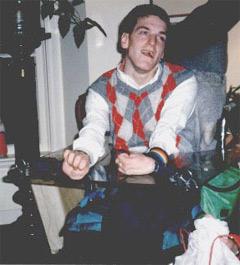Lesch-Nihan syndrome is attributed to hereditary diseases that are associated with metabolic disorders. The disease manifests itself from the first months of life. She is dangerous because there is no specific therapy against her. Treatment only helps to stabilize the condition, but does not completely heal the child, eradicating the cause. What are the features of this pathology? What is the likelihood of developing such a syndrome?
Definition
Among the rare disorders of purine metabolism , the pathology of Lesch - Nihan is distinguished. The syndrome is more common in boys, as it is linked to the X chromosome. It is associated with enzyme deficiency, as a result of which the metabolism of uric acid is disrupted, its amount increases. The accumulation of this substance is manifested by a number of neurological and metabolic manifestations, on the basis of which the disease can be suspected. Strange behavior of the baby requires a medical examination, which includes the collection of general tests and genetic examination.
Etiology
What is the cause of Lesch-Nihan syndrome? The causes of this pathology lie in genetic disorders. This means that the development of pathology leads to the presence of a recessive gene in the mother - the defect is linked to the floor. The development process is described in more detail below. Moreover, the presence of such a gene does not always lead to the development of the syndrome - the probability is 25%. In order to assess the risk of developing pathology, it is recommended to conduct medical genetic counseling.
Genetic disorder
Lesch-Nihan syndrome (a recessive, sex-linked inheritance type) is a serious hereditary disease. It is associated with the defeat of the HPRT gene (hypoxanthine-guanine phosphoribosyltransferase), which is located on the X chromosome - on its long shoulder. Women have two such chromosomes, and men have one, which is why a genetic disorder is more common in the stronger sex. Cases of the development of the syndrome in women are quite rare, and its appearance can be explained by inactivation of the X chromosome.
Biochemical features
In connection with enzymatic disorders, Lesch-Nihan syndrome manifests itself. His biochemistry is a deficiency of hypoxanthine-guanine phosphoribosyltransferase. Under normal conditions, this enzyme is found in all cells, but a greater amount of it is found in brain neurons. A genetic disorder leads to its absence, as a result of which the exchange of hypoxanthine is disrupted. Due to this, an excessive amount of uric acid is formed, which is found in tests in urine and blood. That is why patients develop gout symptoms.
Features has cerebrospinal fluid. It increases the level of hypoxanthine, and not uric acid. This causes neurological abnormalities, and uric acid is not able to pass through the blood-brain barrier. The etiology of behavioral disorders has not yet been established. Scientists do not associate it with an excess of hypoxanthine and uric acid. It is believed that hyperuricemia leads to a lack of dopamine. An increased sensitivity of D1 receptors located on striatal neurons is formed. This can lead to increased aggression.
Clinical manifestations
Associated with genetic disorders is how the Lesch-Nihan syndrome manifests itself. Symptoms of pathology primarily reflect damage to the nervous system. Patients are disturbed by a pronounced convulsive syndrome, while seizures capture individual muscle groups. Hyperkinesis is also common, manifested by twitching of the limbs as a result of spontaneous increase in muscle tone. Children with such a syndrome lag behind in both physical and mental development: their speech is slurred, possibly later the start of walking. Impact on the function of the vagus nerve leads to an increase in the vomiting reflex: gastric emptying occurs without any reason. In addition, paralysis and epileptic seizures are common. The disease is associated with metabolic disorders, resulting in specific manifestations. During the day, as a rule, a large amount of urine is secreted, which is associated with constant thirst and renal pathology. Uric acid accumulates in the earlobes, leading to the formation of so-called tofuses. Urine crystals with an orange color are found in the urine. In addition, joints, usually small ones, are involved in the process. They develop an inflammatory process - arthritis.

Behavior
Does Lesch-Nyhan disease affect lifestyle and habits? The syndrome seriously changes the patient's behavior due to damage to the central nervous system. The child becomes very restless, his mood is constantly changing. Attacks of aggression that can occur without cause at any moment deserve special attention. Such children are prone to self-harm, that is, they inflict bites and scratches on themselves. This is what is considered a characteristic symptom of pathology. Even maintaining full pain sensitivity does not stop patients. They may scream in pain, but continue to hurt themselves.
Diagnostics
The diagnosis of Lesch-Nihan syndrome (photos of patients is presented in the article) is based on a clinical examination and special additional research methods. Three main symptom complexes will help to suggest pathology. Pay attention to muscle disorders of a convulsive nature, a tendency to self-harm and polyuria. A special role is played by trauma to oneself, which should alert parents. After identifying the symptoms of the child, they are sent for analysis of urine and blood. Biochemistry will determine the level of uric acid in these body fluids. It is also necessary to make a genetic examination that will confirm the diagnosis. An ultrasound of the kidney is recommended to identify pathology in them. After confirming the disease, the child is registered with a neurologist and rheumatologist.
Treatment
Pharmacological and non-drug methods help to correct Lesch-Nihan syndrome. Treatment is aimed at preventing complications and improving the condition. To reduce the risk of renal failure, it is necessary to lower uric acid levels, which is achieved by Allopurinol. The use of Diazepam is recommended to calm the patient and eliminate attempts to inflict damage on himself. It is possible to take other sedatives. In addition to this, constant monitoring of behavior is required. In aggressive attacks, the appointment of "Risperidone" is possible. In addition, stressful situations should be excluded. This will help the patient adapt in his environment and enter into close contact with other people. Family support is an essential factor that will help to correct behavior. For protection against self-harm, swaddling or soft gloves are recommended. Previously, they often resorted to tooth extraction in order to eliminate bites. At the moment, the development of medicine, in particular dentistry, allows the use of special plates that are worn on the teeth without causing discomfort to the patient.

Complications
As with most pathologies, complications also occur in Lesch-Nihan disease. The syndrome can lead to consequences associated with the accumulation of uric acid and hypoxanthine. These disorders shorten life expectancy and prevent normal adaptation in society. Among the expressed disorders are arthritis and nephrolithiasis.
Joint inflammation is associated with sedimentation of uric acid. The accumulation of its crystals has a destructive effect on the cartilage tissue and its environment. As a rule, joints of the feet and hands are affected. In the area of inflammation, pain and hyperemia appear. Pain syndrome is aggravated by movement.
Nephrolithiasis (or kidney stones) can lead to complications such as pyelonephritis. The pelvis of the kidney is involved in the inflammatory process . The infection can spread by the hematogenous or urinogenous route and affect the fiber and interstitium. With the transition of inflammation to the chronic stage, irreversible sclerosis processes start. The development of pathology leads to the formation of severe renal failure. Particularly dangerous is the replacement of the structural elements of the kidney with connective tissue; this is what irreversibly violates its function - the release of substances unnecessary to the body.
This is the particularity of the pathology of Lesch - Nihan. The syndrome is completely incurable. Therapy is aimed at reducing clinical manifestations and stabilizing the condition. The patient’s environment and living conditions play a large role in this.